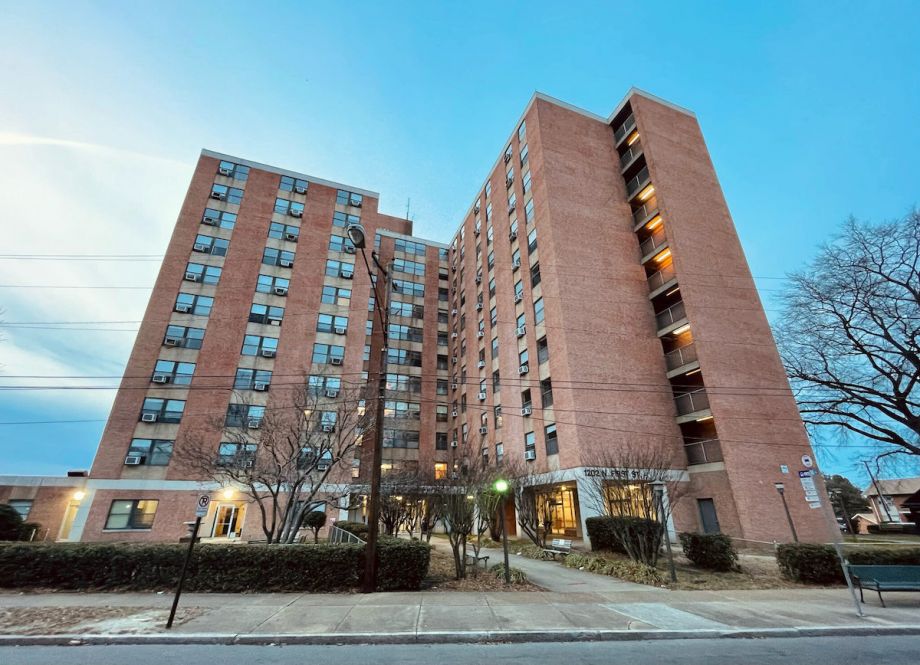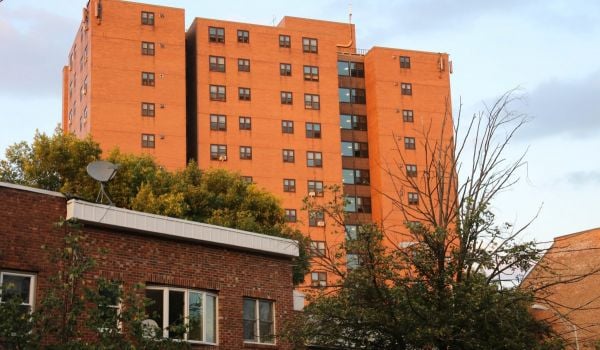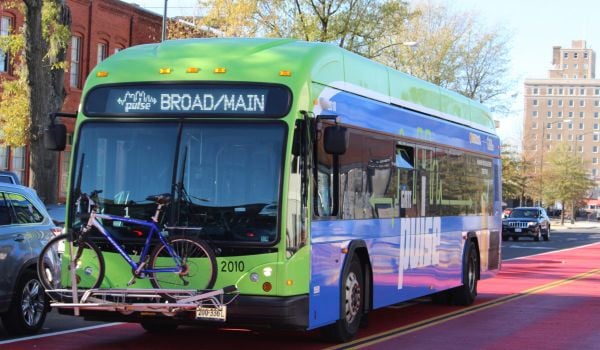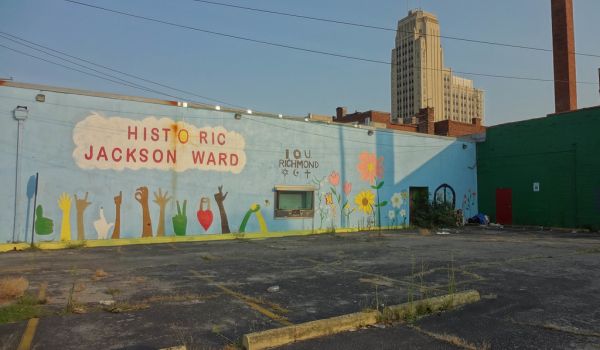This story originally appeared in The Virginia Mercury.
Pipes that repeatedly burst above her bed, old fridges that barely keep food cold and stoves with no child safety protections are just a few of the frustrations that Fredericka has faced throughout the course of the 13 years she has been a resident of Gilpin Court. Despite all of the problems, her toddler still calls her apartment provided by the Richmond Redevelopment and Housing Authority home, and Fredericka believes more folks around town could benefit from such stability.
“I think they should build more [public housing],” she said. “There needs to be more affordable housing out here. The jobs are not paying enough for people to pay market rate rent. Where are they going to go?”
The tension between an unsafe status quo and concerns about what comes next are not unique to Gilpin Court. Whether it’s funding for maintenance backlogs in Roanoke, total teardowns and replacements in Alexandria, or revitalization initiatives in Norfolk and Newport News, if public housing is to remain a backstop against homelessness, then things must change. But how?
‘We can no longer stay with the status quo’
Before the all-white leadership of the Richmond-Petersburg Turnpike Authority demolished the heart of Jackson Ward in 1958 to build what is today Interstate 95, Gilpin Court was known as Apostle Town for the saintly street names which filled the area. Encircled by highways and Shockoe Valley, Virginia’s largest public housing complex and the oldest between Miami and New Hampshire was designed to isolate rather than integrate its residents.
Following only partial efforts toward modernization made back in the 1980s, Gilpin is also in a deplorable state of disrepair. The last structural assessment conducted determined 98% of the public housing complex’s 781 units to be “physically obsolete,” according to RRHA’s new CEO, Steven Nesmith. With 98 buildings spread across 38 acres, the maintenance backlog for Gilpin is millions more than the City of Richmond could ever reconcile.
That’s why Nesmith re-issued a request for qualifications (RFQ) to redevelop Gilpin in February. The original proposal released last October under the former interim CEO outlined a $300 to $400 million dollar redevelopment project on the site. The withdrawal was the result of Nesmith’s desire not to pursue rental assistance demonstration funding in favor of leveraging bond financing “to do something bigger and more transformational,” he said in a recent phone interview.
As the RFQ just closed in April, RRHA anticipates picking redevelopment partners in just a couple months. Although Nesmith can’t share details on the proposals until a decision has been made, he did hint that “the quality of those that have submitted is satisfying.”
A dream redeveloped
Growing up in public housing in a family on welfare, Nesmith rose through the ranks of the affordable housing industry to become a deputy secretary of the Department of Housing and Urban Development during the second Bush administration and understands the importance of quality communities for people in poverty. That’s why his vision for Richmond’s “Big Six” public housing courts and their roughly 9,100 residents is anything but modest.
Although Nesmith doesn’t want to expand public housing in Virginia’s capital, he has agreed to a one-for-one replacement of units — long a major fight between residents and RRHA’s leadership.
For the neighborhood that comes after Gilpin, Nesmith envisions women- and minority-owned businesses, a resident reinvestment fund, grocery stores, a community health clinic, a job training center, and a mixture of multi-family rental units and single-family homeownership options for current public housing residents. Additionally, the whole mixed-use, mixed-income redevelopment will be done to meet Mayor Levar Stoney’s goal of an additional 1,000 new affordable rental units each year and in concert with Richmond’s Jackson Ward Community Plan to stitch Apostle Town back together with its southern neighbor.
If Gilpin’s residents are as well taken care of as those who moved out of the now demolished Creighton Court and into the mixed-income Armstrong Renaissance community next door, then LaFonda Page — a former public housing resident and current organizer for the Legal Aid Justice Center — believes the redevelopment will be welcomed by residents with open arms.
“I think most of them want to get up out [of] there,” she said. “People deserve better. They don’t want to stay there. The older ones might want to come back, but most of the younger ones don’t want to. I don’t care about no damn new appliances. I wouldn’t want to be back there either.”
Maryland the role model
That RRHA has opted to demolish and redevelop Richmond’s public housing courts comes as no surprise to Paul Williams, executive director of the Center for Public Enterprise, a nonprofit think-tank working to grow the public sector.
“This is what every public housing authority in the country is doing,” he said. “The national political trajectory has forced public housing authorities into a position where this is the only option to meet the needs of residents. Until Congress appropriates the funds that public housing requires and needs, conversions are the only viable tool in housing authority directors’ pocket to give residents the quality housing they deserve.”
Since Congress slashed funding for Section 9 housing projects like Richmond’s Big Six in the 1990s, Section 8 housing choice vouchers have been the main model for public housing authorities to move residents out of dilapidated dwellings and into higher quality units. That’s how RRHA relocated the 200 seniors living in Fay Towers in Gilpin Court to three new affordable apartment buildings in Highland Park and Jackson Ward several years ago.
One community breaking the mold is Montgomery County, Maryland. Local officials there established a revolving Affordable Housing Opportunity Fund to begin expanding the county’s public housing stock. Since the program allows developers to use their own financial resources to fund construction, no HUD grants or federal subsidies are necessary to complete innovative projects, such as constructing affordable housing atop public buildings like fire stations, libraries and recreation centers.
“Right now, housing authorities are constrained in what they can build by the lack of money from Congress,” explained Williams. “What makes Montgomery County’s approach so attractive is that it allows public housing authorities to build and maintain more affordable publicly-owned housing than they are able to with their current allotment of subsidies.”
Currently, no Virginia localities use such a model to improve and increase their public housing stock. Nesmith hopes the establishment of the Richmond Development Corporation this February could have a similarly transformative impact by leveraging private sector bonds and lending.
A similar entity in Norfolk has created more questions than affordable housing answers by lending everywhere but the city it’s supposed to serve, but Nesmith guarantees the new RDC will be “Virginia focused only, especially the Richmond region.”
Williams doesn’t knock housing authorities for getting creative to care for their residents given the tremendous deferred maintenance backlog and the paltry financial support from elected officials.
“If they want other options, they have to come in the form of money, which housing authorities don’t have,” he said. “Congress could give it to them. State governments could give it to them, but almost no state budget in the country gives housing authorities the money they need to do things in a better way.”
This article is part of Backyard, a newsletter exploring scalable solutions to make housing fairer, more affordable and more environmentally sustainable. Subscribe to our weekly Backyard newsletter.

Wyatt Gordon is a born-and-raised Richmonder with a master’s in urban planning from the University of Hawai‘i at Mānoa and a bachelor’s in international political economy from the American University in Washington, D.C. He currently covers transportation, housing, and land use for the Virginia Mercury. He also works as a policy and campaigns manager for land use and transportation at the Virginia Conservation Network. Wyatt is a proud Northsider you can find walking, biking, and taking the bus all over town.


















